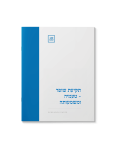תקיעת שופר – טעמיה ומשמעותה
$39.00
בירור מקיף על מצות שופר ומשמעותם הפנימית של סוגי הקולות וסידורם לאור החסידות.
| Language | Hebrew |
|---|---|
| Paper Type | Research Paper |
| Pages | 9 |
Related Products
This paper features a curricular overview of the mitzvah of experiencing Oneg Shabbos.
The shofar is an ancient musical instrument used to call the Jewish people together. It was blown to announce the new month, before the commencement of battle, and other occasions. It is still used on Rosh Hashanah and the closing of Yom Kippur to call the people to repentance. When was the shofar used for the first time?
One of the the central themes of Chanukah is Pirsumei Nisa, the public display and celebration of the holiday. Around the world, Menorah’s are kindled in Malls, at City Halls and all sorts of public places. May one recite the traditional blessing over the Chaukah lights if they are being lit in the city square and not in the privacy of one’s home or Shul?
Brushing teeth triggers various halachic concerns about the violation of Shabbat. This paper deconstructs the practices of oral hygiene to examine if there are issues of chovel, schita, uvdin d’chol and memareach.
The mandate to rest on Shabbos also precludes having work done for us by gentiles, under specific conditions.
May one send Priority, Express or 2nd Day Mail on Friday? What about ordering through Amazon Prime?
What may one say (or dictate) when scheduling shipping without violating Shabbos by proxy?
Shabbat candles are perhaps one of the most evocative images of Jewish life. What is the source for this practice? Where, and how many, Shabbat candles are lit?
Have you set up “Hey Siri!” on your iPhone yet? How about the Amazon Echo to obediently adjust your thermostat, turn on your lights and play your favorite music – all by the sound of your voice?
During the week this might be great, but what about on Shabbos? Do the laws proscribing creative activity extend to actions that result from our verbal expression? What if some technology was devised to act upon your thoughts?
Related: “An Uplifting Shabbos” and “Motion-Triggered Sensors”
Given that both Haman and ‘the Manna’ are spelled the same,
is there any deeper connection between the two?
Legend of a Cookie – The Purim cookie. Three corners, folded to swathe a filling. Supposedly it is named after the wicked Haman from the Purim story. How is this cookie reminiscent of the wicked Haman? (Sources)
Inviting non-Shomrei Shabbat to attend Shul or meals at your
home is often also an invitation for them to drive on Shabbat. What are the
laws of this overlooked yet critical issue? Do the ends ever justify the means?
How can we balance our love for our fellow with our love for halacha?
Further restricting an already slimmed down Pesach diet is not something anybody would eagerly embrace. But the Jews of medieval Ashkenazic communities adopted the stringency of avoiding the consumption of legumes throughout the duration of Pesach. The question is, why? How was this ban treated for the centuries that have since passed? Was it adhered to equally in times of prosperity and adversity?
The popularity of Smart Sensors is on the rise. As more aspects of ordinary life are administered by electronic mechanisms, many practical questions are raised about how observant Jewish life is impacted by the new technology.
When the stairwell lights only turn on when sensing your presence, can you use them on Shabbos? What about the inadvertent motion that triggers a neighbors’ outdoor lights? Can you be present in a room that is monitored by closed-circuit surveillance cameras?
A summary and index of the major contemporary Poskim on this issue.
See also: “An Uplifting Shabbos” on the general issue of Electricity and Shabbos.
The Blowing of the Shofar: Reasons and Significance













![Banning the Beans: How Kitniyos Became Off-Limits [New!]](https://catalog.myjli.com/wp-content/uploads/2025/05/MSBTB-350x448.png)

